Menu
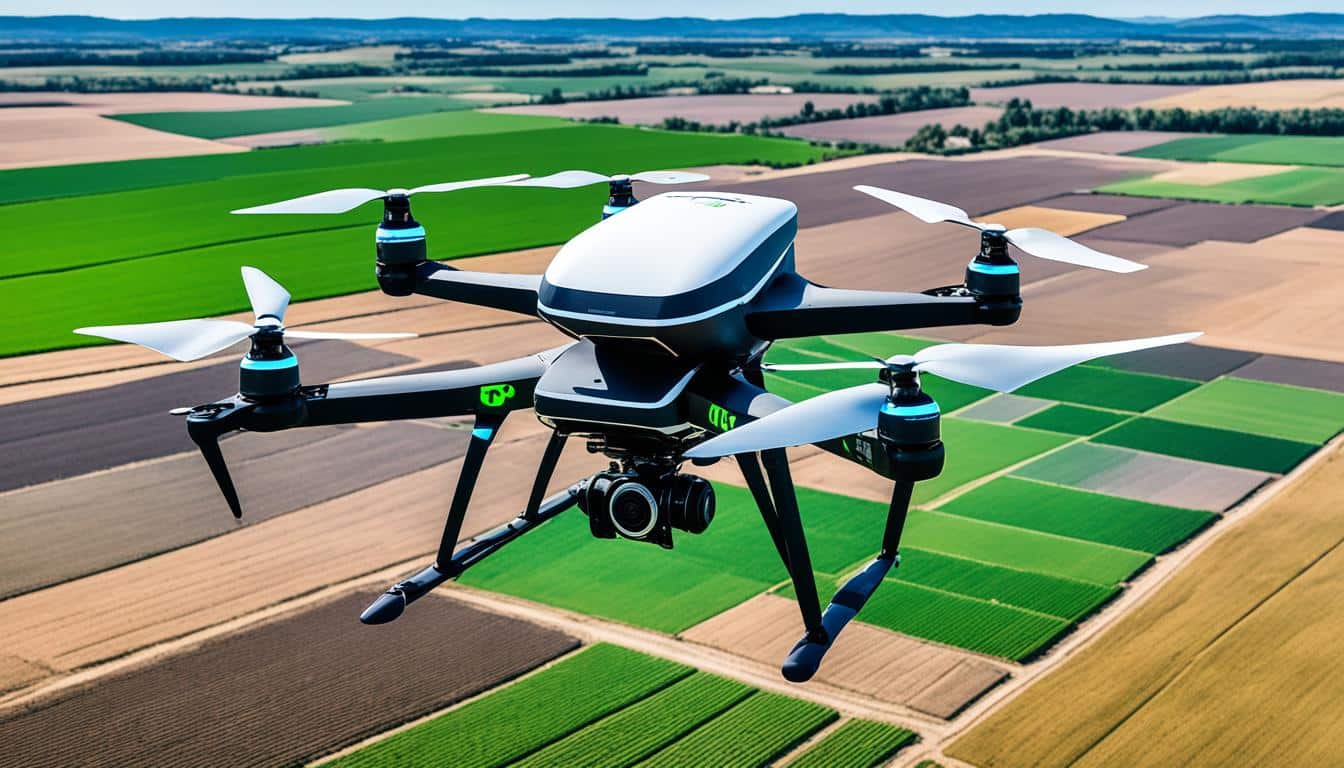
Did you know, the AI in agriculture market could leap from USD 1.7 billion in 2023 to USD 4.7 billion in 2028? This big jump highlights the huge changes AI solutions are making in farm management.
With the world’s population set to hit 10 billion by 2050, farmers need to produce more food. They face many challenges, like climate change, less land, not enough workers, damage to the environment, and weaker soil. AI in farm management is now key to making agriculture smarter.
Companies such as Intellias are at the forefront with the latest tech for farming. They provide tools for everything from checking quality, following products, to meeting rules. AI does many jobs well, like using data to farm better, saving money, and helping when there’s not enough workers.
AI is crucial for modern farming to tackle the big issues we face today.
The world of farming has changed a lot over time. We’ve gone from simple tools to high-tech machines. This change has all been about making farming more efficient and productive. This journey is highlighted by the use of agriculture technology.
Farming used to be all about hard work with basic tools, which was not very effective. However, with the introduction of modern farming technology, things have changed. Machines like tractors, harvesters, and irrigation systems have made a big difference. These are not just helpful but now necessary, as our world’s population is expected to hit 10 billion by 2050.
Today, technology plays a huge part in farming. It includes everything from AI to tools for precision farming. For example, AI-powered drones can give farmers up-to-the-minute crop information. They can suggest spots that need more water, fertiliser, or help with bugs. Thanks to AI and sensors, farms can automatically adjust their watering based on how dry the soil is and the weather. This is known as smart farming evolution and it makes farms more efficient thanks to data use.
The rise of AI farm management is a major step forward. This area uses big data and maths to offer top-notch solutions for everything from watching over the crops to checking the soil. There are already success stories, like AI that can spot apple black rot with more than 90% accuracy. Companies like FarmWise and Blue River Technology show that AI can turn complex data into solutions for better and more sustainable farm management. AI-powered systems make planning the crops, allocating resources, and keeping track of money much easier. So, using these smart systems points to a bright, sustainable future in farming.
For instance, AI can spot pests, diseases, and water leaks in irrigation systems. It helps farmers act quickly and precisely. It’s clear that AI is changing the game in farming, making it more able to cope with tough environmental issues.
| Year | Market Value (USD Billion) |
|---|---|
| 2023 | 1.7 |
| 2028 | 4.7 |
AI’s presence in agriculture is growing fast. The market is set to expand from USD 1.7 billion in 2023 to USD 4.7 billion by 2028. These numbers show why AI is key for farming’s future. It’s all about using modern farming technology to boost efficiency and care for the planet.
AI tech in farming has changed how we grow crops. It brings big benefits like making farms smarter, cutting costs, and helping farmers make better decisions.
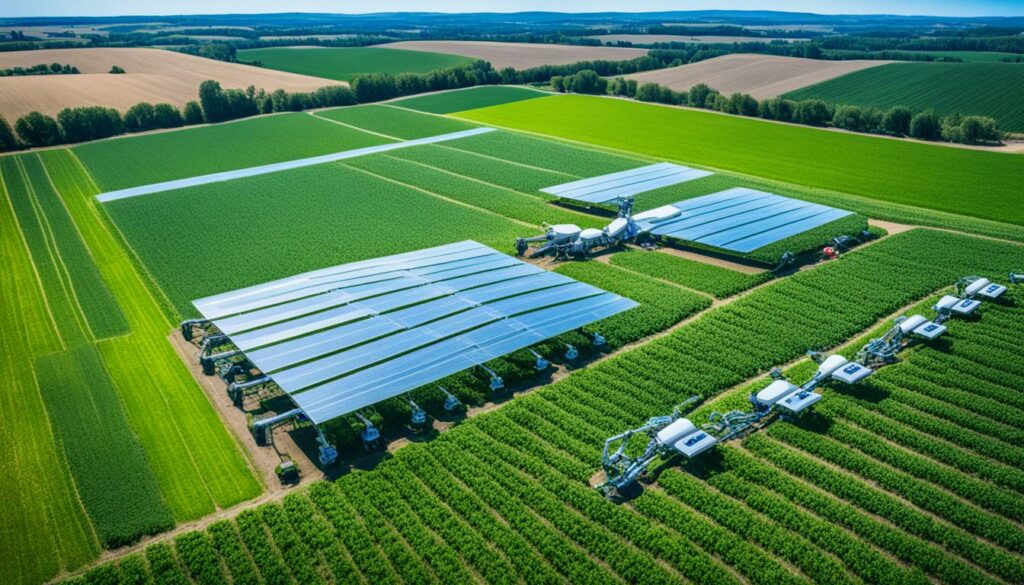
AI boosts how well farms run. It cuts down on the work farmers have to do by analysing a lot of data quickly. This means farmers can look after their crops better. They get help spotting problems early, like pests and diseases. AI also tells them the best times to water their plants. This makes farms more productive because farmers can act fast on what AI tells them.
AI is a game-changer for saving money in farming. It helps farms use less and produce more. For example, AI drones can spray pesticides exactly where needed. This avoids wasting money on too much pesticide. Plus, AI helps farms know when they need better drainage or more fertiliser. These small, smart adjustments lead to big savings over time.
One big benefit of AI is helping farmers make better choices. By looking at lots of data, AI gives farmers insights they wouldn’t have otherwise. This helps them decide the best times to plant, feed, and harvest. AI also uses trends to predict market conditions. This means farmers can plan ahead and avoid problems. So, AI makes farms stronger and more able to deal with challenges.
| Aspect | Impact of AI |
|---|---|
| Efficiency | Enhanced through streamlined data processing |
| Cost | Reduction via precise resource application |
| Decision Making | Improved with real-time data insights and forecasting |
By 2050, Earth will have 10 billion people needing food. Farms must grow more food with less waste. Precision farming, using AI, steps in to help. It uses real-time data and clever predictions to make farming smarter.
AI is changing how farms use resources like water and fertilizers. It looks at data to use these things wisely, cutting down on what’s wasted. For example, AI can spot which fields need watering, saving water in the process. In Australia, AI in farming made irrigation 20% better, saving a lot of water.
AI processes farm data quickly, giving farmers instant clues on what to do. It can see what areas need more care. For example, AI can find diseases in plants with over 90% accuracy. This helps farms work smarter, using less and protecting the environment.
Predictive analytics are key for looking ahead in farming. AI uses past data and weather to guess what crops will need, helping farms get ready. By predicting needs, AI supports farming that’s both productive and kind to the planet. It helps keep the balance between using resources and protecting nature, making farms ready for the future.
A mix of AI and precise farming is making agriculture better and greener. As the AI market grows to USD 4.7 billion by 2028, it’s clear that smart farming is the way forward. It helps us meet the challenge of feeding the growing world.
By 2050, our world will have nearly 10 billion people. This means we need to find new ways to grow more food. Autonomous farming tech is key in this change. It uses AI and machine learning to run farming tasks automatically. This boosts how much food we can grow and does it more efficiently.
Driverless vehicles in farming, like tractors and harvesters, are changing the game. They don’t need people to operate them. Instead, they use sensors, GPS, and intelligent algorithms to work on fields precisely. They can plough, plant, and harvest crops with very few mistakes. These automated systems make farming more productive. They also lower the costs of labour and fuel.
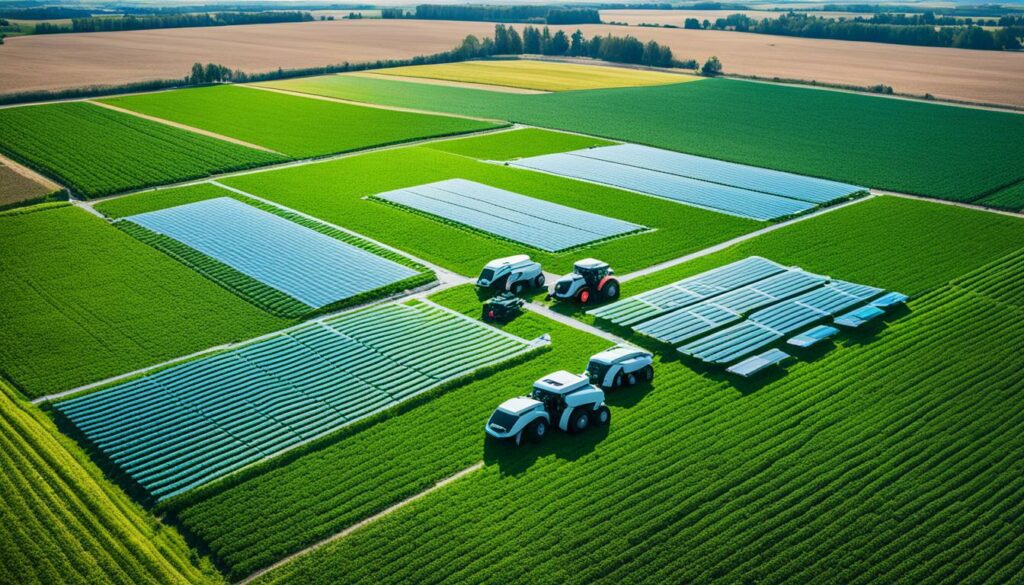
Automating irrigation and harvesting is another big leap forward. AI makes it possible to water crops exactly as needed. This saves water and helps the plants grow better. Harvesting is also smarter with these systems. They use sensors and robots to pick the best crops. This leads to more crops collected and less waste.
Smart greenhouses use AI to grow plants better. They’re led by AI to control the perfect environment for plants. This includes managing temperature, humidity, and sunlight. These smart systems help farmers grow better quality crops and more of them. They also reduce the impact of changing climates.
The use of AI in agriculture is growing fast. By 2025, it’s expected to reach $2.6 billion. This growth offers great chances for better crop watching and health checks. Since farming uses up most of the world’s freshwater, it’s critical to manage it well. Plus, fighting off weeds costs over $11 billion. This shows why we need to use AI and drones on farms more.
Drones are changing how we see farming from above. They have cameras that take photos of farms from the sky. These photos show the farm’s ups and downs. For example, they help to see where it’s too wet or too dry. This helps farmers to use water and other resources better. As a result, crops grow healthier.
AI is making it easier to spot when crops are sick. It can see plant diseases very precisely. This means we can use fewer chemicals and farm more sustainably. Spotting diseases early helps stop them from spreading. This saves crops and improves their quality.
AI also helps predict how much crop we’ll get. It does this by looking at lots of data and using smart computer models. Using these predictions, farmers can plan better. They can use their resources in the best way. This smart farming approach boosts how much crops we grow. It also helps deal with the changing weather.
Thanks to AI, farming is getting smarter. It helps keep crops healthy, boosts their growth, and protects the environment.
AI is shaking up agriculture, especially in dealing with pests and weeds. It’s a big change from the old ways. Now, farmers can do better and be friendly to the planet using AI.
Intelligent pest management is all about using AI to detect and watch out for pests. It’s like having a smart plan to deal with bugs before they cause big problems. Sometimes, AI can even tell when there might be a lot of pests coming, using all kinds of data like weather and bug life cycles.
Take the case of cotton farmers fighting bollworms without using too much pesticide and getting more crops. This approach helps the environment, controls costs, and makes people happier with their products. By using just enough pesticide in the right places, there’s less harm to nature.
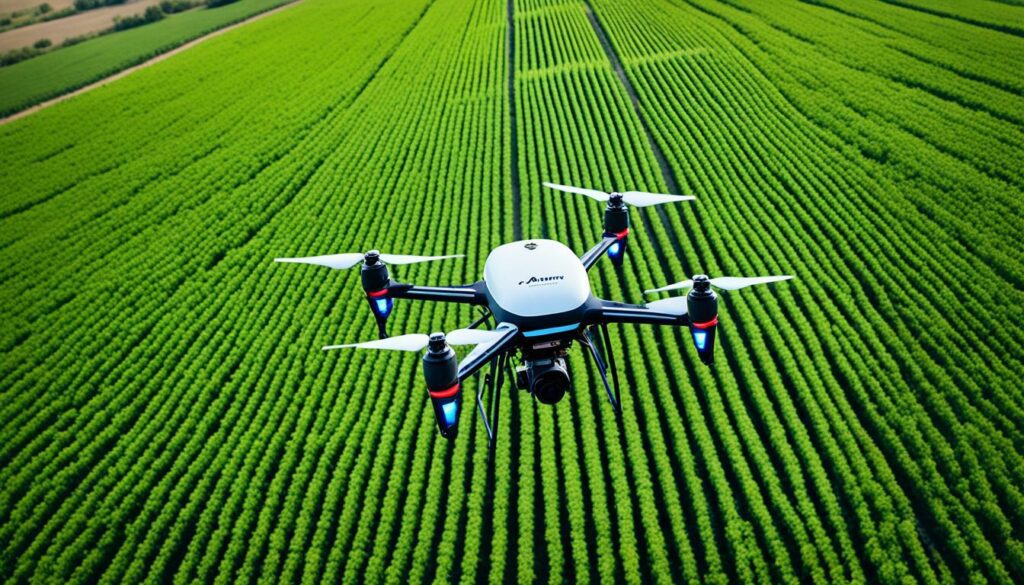
AI has also made a big difference in spotting weeds. Advanced cameras and AI are the eyes of systems like Solinftec’s Solix Ag Robotics, working at night to tackle weeds fast. This tech is a real game-changer, covering way more ground than people can, even with lots of workers.
Thanks to AI, we can use much less weed killer and still keep the fields clear. Take the Laserweeder, for example. This massive machine zaps weeds with lasers. It can do a huge job every day with no need for harsh chemicals, thanks to its super smart technology.
Then there are companies like FarmSense, using AI to find smart ways to deal with pests. Their work shows how important it is to have good data for AI to really work well. AI in pest and weed control helps farms be green and efficient, showing its key role in farming today.
The arrival of AI farm management systems marks a new era in agriculture. It joins old farm customs with new, high-tech agri-tech advancements. This mix is making farms more efficient and earth-friendly. Now, IoT devices in farm buildings are collecting detailed data on how energy is used, equipment performance, and the environment. This information is fed into AI systems. They use it to run farms better.
The AI Energy CoPilot by Edgecom Energy is a great example of this. It offers instant advice and personalised plans to save energy and lower emissions. These AI systems can work with green energy sources like solar and wind power. They’re changing how farms operate by using smart predictions. This means that farms can be efficient before problems even arise.
AI is also transforming how we use energy on farms. It can cut down on energy usage by up to 15%. This is a big step that shows AI’s power to change farming. With AI’s help, farmers can figure out where to use less energy. They can then manage their energy use better. This even helps control a farm’s inside climate. AI can match up heating, cooling, and air flow to make the perfect conditions for crops.
AI farm systems get even better at saving energy by spotting and fixing problems. They’re very good at making the most of light in greenhouses and vertical farms. This saves energy and boosts plant growth. The way AI and energy systems work together is changing farming. It’s helping deal with many issues, both environmental and economic, that farmers face.
As the demand for AI in farming grows from USD 1.7 billion in 2023 to about USD 4.7 billion in 2028, it’s obvious AI is essential. It’s leading the charge in making farming better with its agri-tech advancements.
By 2050, our planet could house 10 billion people. With this growth, farming faces new challenges every year. To tackle them, the agricultural sector turns to AI and big data. These tools provide insights like market demand analysis and predictive farming analytics to stay competitive.
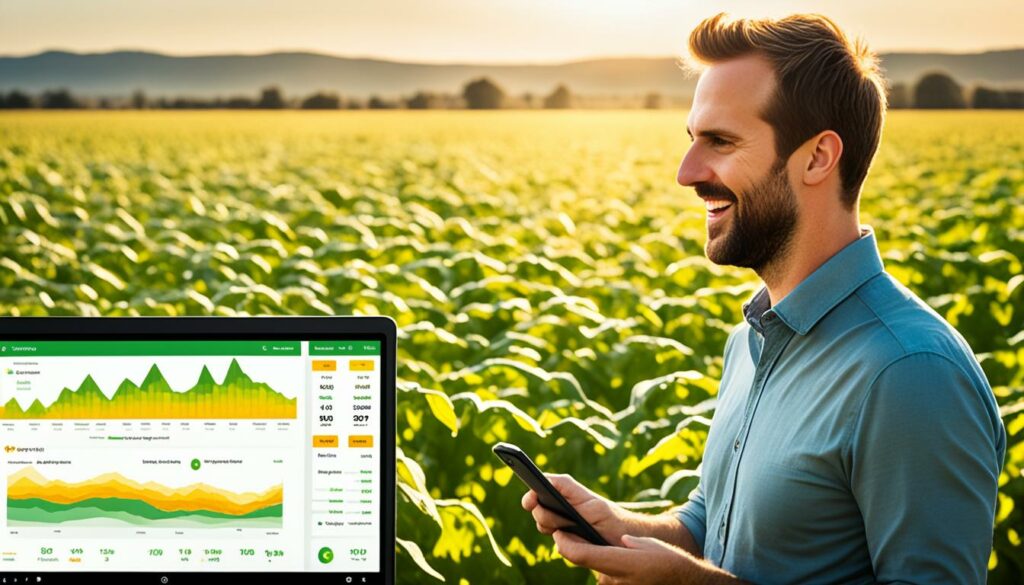
Big data is transforming farming through AI. It helps farmers know exactly when to harvest crops. With the right technology, farmers can predict future yields more accurately. This allows them to better manage their fields.
Understanding what crops people want is vital. AI looks at past trends to project demand. This information helps farmers make smarter decisions on what and when to plant.
Companies like CropTrak have spent over a decade helping farmers use AI effectively. They’ve found better ways to measure crop quality and spot problems early. This makes their crops more desirable in the market.
Quick decisions are vital in farming, but the landscape is ever-changing. AI gives farmers data in real time. This allows them to address issues with water, fertilisers, or pests fast.
For example, AI can detect problems with irrigation systems early. This saves water and makes farming more efficient. Drones with AI also help by spraying pesticides only where needed. This means less environmental harm and healthier crops.
AI in farming isn’t just about being more productive. It helps farmers meet market needs better. This marks the start of a new age in farming, which is guided by smart, data-driven decisions.
AI in managing livestock is changing the game. It brings new levels of accuracy and speed to farming. This tech boosts farm work efficiency and keeps animals healthier.
AI is a game-changer in watching over animal health. It spots health issues early, stopping diseases from spreading. With smart systems, data on an animal’s weight and health status is constantly updated. This helps in making the right moves at the right time.
The University of Florida has found great success using AI to better cattle health, milk production, and reproduction. This shows how valuable the tech is.
AI is key in making sure animals get the right food. It tracks what each animal needs and ensures they get it. This tailored approach helps animals grow well and stay productive.
Systems like MilkingCloud use AI to watch how animals eat. This develops programs that save food, reduce waste, and are kinder to the earth.
AI changes how we look at what animals do. It can read their movements and behaviours. Not just that, it can tell their well-being from how they stand or even by studying their droppings.
This detailed view helps farmers improve how they care for their animals. It boosts the animals’ wellbeing and makes the farm run better. By keeping ahead of problems, AI makes farms safer for the animals and the people who look after them.
AI in livestock management covers a wide range of benefits. From health to food to understanding animals better, it makes farming better. These smart tools enhance farming and care for animals in amazing ways.
Artificial intelligence has big potential in farming, but it faces many challenges. These stop it from being used widely.
Getting AI tech for farming costs a lot at first, creating an economic problem for many farmers, mostly small ones. Using AI tools like machinery, drones, and analytics needs a big initial investment. Even with the market for AI in farming expected to triple by 2028, high start-up costs make it hard for small farmers to access these technologies. This divide can grow between big farms and smaller ones.
The change to AI in farming isn’t only about money. It also means fewer jobs, a big worry. AI can do many jobs people do now, like picking crops or controlling pests, without needing people. This can make it harder for people to find work, especially in places where farming is most jobs. Switching to AI means we have to think about how to retrain workers for new jobs, to help avoid unemployment.
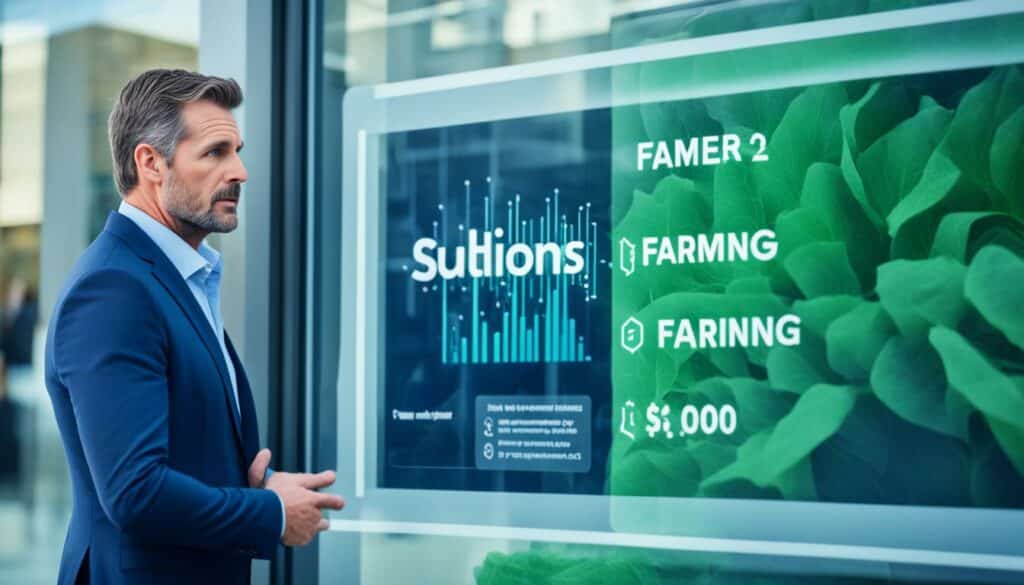
Keeping farm data safe is very important as farms use more digital tools. AI collects a lot of data, like soil details and crop health, which makes it a big target for hackers. With more farm gadgets connected to the internet, it’s crucial to have strong privacy rules. Farmers need to be sure their data is safe and used properly. Making sure data is well-protected is key to farming trusting AI and using it well.
It’s crucial to work on these challenges so everyone in farming can benefit from AI, not just a few. By making AI more accessible and fair, we can have agriculture that’s advanced for everyone.
By 2050, there will be almost 10 billion people on Earth. This puts a lot of pressure on farming to grow more food. Luckily, AI is helping in big ways. It’s saving water, checking the soil, and cutting down on harmful gases.
Farms often struggle with not having enough water. AI is making it better with smart watering systems. These systems make sure not too much water is used. They find leaks and check if the soil is too dry or wet. Reports show that farms can use less water and still grow just as much.
For farming to last, the soil must be healthy. AI tools keep an eye on the soil. They tell farmers what the soil needs, like more nutrients. This helps the soil stay good for growing things. Thanks to AI, farms can grow more food, up to 15% more, without harming the soil.
Farming has a big impact on the planet. AI is helping to make it cleaner. It’s using less chemicals and fuel. This cuts down on harmful pollution. With AI, farming can be good for the earth and still feed everyone.
In the near future, AI’s role in farming will grow a lot. New technologies in farming are about to bring big changes. They promise to make farming more efficient and good for the environment. AI is becoming a vital part of farming as it helps solve many problems the industry faces.
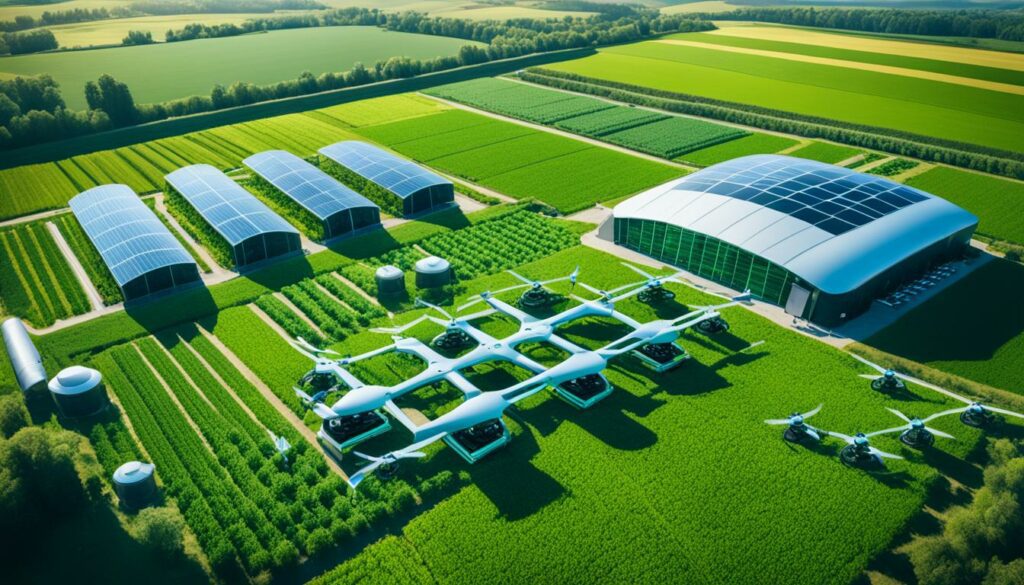
New AI models will soon analyse data in real time and predict farm issues. This means farmers can solve problems before they get too big. AI can work with lots of data, offering solutions for different climates and soils around the world. It helps with things like accurate crop monitoring to catch pests and diseases early.
NatureFresh Farms is heading into this future by using technology in their greenhouses. They have thousands of devices keeping an eye on things to help plants grow better. This shows how AI might be used more widely to make farming smarter.
For AI to really take off in farming, there needs to be good rules and support. Policy makers are working on setting helpful standards and making sure AI is used right. Having clear rules will take away worries for farmers and tech companies. This can make a good space for everyone to try new things. Also, help from the government, like money or support, could make it easier for smaller farms to use AI.
AI’s effect on farming around the world is huge. It can help farms of all sizes improve. This is important because farms in different places have their own challenges. For example, in India, there isn’t much land to farm on. And many places rely on rain for farming.
As we look to make more food by 2050, AI in farming is key. It can help make sure there is enough food. AI can also change how we get food from the farm to the market. This way, everyone can have access to better, fresher food. AI is ready to make our farms stronger and able to face big challenges.
By 2050, the world population could reach 10 billion. This puts great pressure on the agricultural sector to increase yield. AI in farming stands out as a key innovation. It brings several advantages like better efficiency, lower costs, and smarter decisions. The market for AI in agriculture will likely grow from USD 1.7 billion in 2023 to USD 4.7 billion by 2028. This shows more farms are adopting these advanced tools.
AI-based predictive analytics let farmers use data quickly. They can understand market needs, predict prices, and choose the best times to plant and harvest. With AI, precision farming allows for more crop production with fewer resources. This cuts down costs but increases yields. AI is also great for managing resources better. It helps with smart irrigation and keeping greenhouses just right.
Yet, there are challenges like the cost of starting AI on farms and worries over who owns the data. There’s also the issue of jobs that AI might take over. Despite these problems, AI has a clear positive effect on farming. It makes farms more efficient and speeds up the use of new technology. Looking ahead, future tech like better algorithms, more robots, and self-sustaining systems aim for even better farming. Smart farming is becoming not just an option but something vital for farming that’s both sustainable and efficient all over the world.
AI boosts farm management using data-driven solutions. It encourages farming innovation and supports sustainability. This tech makes things more efficient, cheaper, and helps with decisions.
From basic manual work, agriculture now includes high-tech solutions. Advanced tech like precision farming and smart farming have made farming more productive and efficient.
AI improves efficiency and cuts costs in farm management. It’s great for making smarter decisions. By analysing data, AI helps farmers do everything better.
AI in precision farming uses data to manage resources better. This means better planning and less waste. It helps farmers get the best results with fewer resources.
Autonomous farming means using machines without a need for people. This includes driverless tractors and smart greenhouses. It lowers the chance of mistakes and boosts how much we produce.
AI watches over crops by using drones and sensors for info. It spots diseases early and predicts how much we’ll harvest. This early info helps farmers manage their crops better.
Yes, AI can tackle pests and weeds better. It uses data to target the pests and weeds correctly. This means using fewer chemicals and looking after the environment more.
AI is changing farming with new tech like never before. By using AI, farming is becoming more sustainable and productive. It helps solve today’s farming challenges.
Data analytics with AI changes how farming is run by providing helpful insights. It predicts market needs, sorts out schedules, and boosts profits. These tools help farmers in many ways.
AI looks after the health of animals, makes sure they eat well, and checks how they behave. It makes animals healthier, helps them grow well, and gives farmers lots of info on their animals.
There are hurdles in adopting AI in farming, like high costs and worries about jobs and data privacy. Solving these challenges is important for using AI smoothly.
By using AI, farming can save water, keep an eye on soil health, and use less energy. These steps help keep farming going for the long term and protect the environment.
AI has a bright future in farming, offering continuous innovations with support from new rules. Its ability to grow and affect the world signals big changes in how we farm.